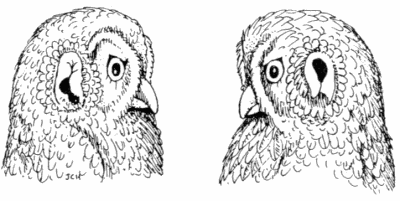From Cognitive Neuroscience (p. 168):
Barn owls rely on two cues to localize sounds: the difference in when a sound reaches each of the two ears, the interaural time, and the difference in the sound's intensity at the two ears. Both cues result from the fact that the sound reaching two ears is not identical. Unless the sound source is directly parallel to the head's orientation, the sound will reach one ear before the other. Moreover, because the intensity of a sound wave becomes attenuated over time, the magnitude of the signal at the two ears will not be identical. The time and intensity differences are minuscule. For example, if the stimulus is located at a 45° angle to the line of sight, the interaural time difference will be approximately 1/10,000 of a second. The intensity differences resulting from sound attenuation are even smaller -- indistinguishable from variations due to noise. However, these small differences are amplified by a unique asymmetry of owl anatomy: The left ear is higher than eye level and points downward, and the right ear is lower than eye level and points upward. Because of this asymmetry, sounds coming from below are louder in the left ear than the right. Humans do not have this asymmetry, but the complex structure of the human outer ear, the pinna, may amplify the intensity difference between a sound at the two ears.



0 comments:
Post a Comment